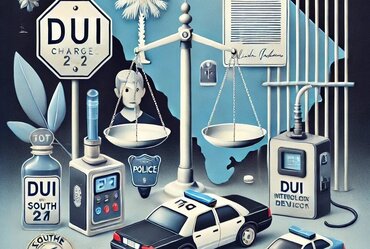
Receiving a traffic ticket can be frustrating and inconvenient, but it’s not always the end of the road. Many drivers may not realize that they have the option to contest a traffic violation. Successfully challenging a ticket can save you from paying hefty fines, accumulating points on your driving record, or facing increased insurance premiums. Here’s a comprehensive guide on how to fight a traffic violation effectively. 1. Understand Your Violation The first step in fighting a traffic ticket is to understand the nature of the violation. Carefully review the ticket for details such as the type of infraction, the location, and the officer’s observations. Common violations include speeding, running…Read More

Criminal law statistics provide valuable insights into crime patterns, justice system efficacy, and societal challenges. By examining these data points, policymakers, legal professionals, and the public can better understand the prevalence of various crimes, the performance of law enforcement, and the effectiveness of rehabilitation efforts. This blog explores some key criminal law statistics in the United States and their implications. Understanding Criminal Law Statistics Criminal law statistics encompass data related to reported crimes, arrests, convictions, and recidivism rates. They serve as a barometer of public safety and highlight areas that require attention. Common categories include violent crimes, property crimes, drug offenses, and white-collar crimes. These metrics often reflect the socio-economic…Read More

Traffic violations encompass a broad array of infractions that can occur when drivers operate vehicles contrary to established road laws. While hearing the term might immediately conjure images of flashing lights and radar guns, it's crucial to understand the broader implications and legal nuances associated with these offenses. Not only do traffic violations impact road safety, but they can also have significant financial and legal consequences for drivers. Types of Traffic Violations Traffic violations can be broadly categorized into two main types: moving and non-moving violations. Moving violations are those that occur when the vehicle is in motion. Common examples include speeding, reckless driving, running a red light, and driving…Read More

Drug offenses have long been a contentious issue within society, permeating legal systems and sparking intense debate about public health, justice, and policy reform. These offenses, ranging from possession and trafficking to manufacturing and distribution, carry significant legal consequences that resonate deeply at both individual and societal levels. Understanding these offenses entails exploring their legal classifications, examining their societal impacts, and discussing potential reformative approaches. Legal Classifications of Drug Offenses Drug offenses are categorized based on the severity and nature of the activity. Generally, these classifications fall into three primary categories: possession, trafficking, and manufacturing/distribution. Possession refers to the act of having a controlled substance in one's personal domain. Depending…Read More

The possible punishments for a Class B felony also differ according to the area and the crime committed. However, the maximum imprisonment years one may be given after being convicted of a Class B felony is at least one year but at most 25 years, and other forms of punishment such as fines. The judge may also order probation or community service as part of the whole of the punishment. Some states with mandatory minimum sentences may apply to Class B felonies in which case, if you have been convicted of the offense, you have to spend time in prison no matter the circumstances. Praise to violating the laws ranging…Read More

Being arrested for driving under the influence (DUI) can be a daunting and overwhelming experience. The legal proceedings, potential penalties, and personal ramifications can leave you feeling uncertain and anxious about the future. Understanding what to expect after a DUI arrest can help mitigate some of these fears and better prepare you for the journey ahead. Immediate Aftermath of the Arrest After being pulled over and arrested on suspicion of DUI, you will likely undergo a chemical test, such as a breathalyzer or blood test, to measure your blood alcohol concentration (BAC). Following this, you will be taken into custody, where you may be held until you sober up or…Read More

Criminal offenses which fall under Class B, Class 2 or Level 2 are generally among the most severe criminal offenses in any state. Most states, as well as the federal criminal code, divide their felony crimes from the most severe to the least severe. Some states prefer to label or categorize them as ‘Class’ like Class A, B and C or classes 1 to 5. Some categorize using small numbers, that is Level 1, Level 2, Level 3 and so on. This article will also consider describing the most frequent Class B, Class 2, and Level 2 felons and repercussions they will face. This offense level depending on the number…Read More

In the complex world of law, criminal defense stands out as a dynamic and essential field, dedicated to upholding justice and safeguarding individual rights. Whether a person stands accused of a minor misdemeanor or a major felony, the role of a criminal defense attorney becomes not just pivotal but indispensable. This blog post delves into the heart of criminal defense, exploring its significance, challenges, and the essential qualities required in a successful defense attorney. Understanding Criminal Defense At its core, criminal defense involves representing individuals or entities accused of criminal conduct. The legal system presumes innocence until proven guilty, and it's the defense attorney’s role to ensure this fundamental right…Read More

Having a DUI charge is an extremely stressful period of time if a person at all experienced the situation. This article explains what stands for DUI, what follows after a DUI charge and the kind of consequences a person can expect. DUI stand for driving when influenced by alcohol or drugs. It is most related to driving while intoxicated; however, some get behind the wheel after taking illicit drugs or prescription medicine. Although the acronym for driving under the influence of alcohol is DUI, some states use DUI, DWI, OUI or OWI. While the acronyms may differ slightly, they are all essentially a category of trying to operate a motor…Read More

The secretary method can be of great use in your effort to prevent yourself from getting arrested for DUI. 1. Make A Plan Ahead of Time You need to define and know your limits and also look for ways that can help you to avoid the DUI situation all together. This is usually the best time to program your escape back home when you are going out at night. Just name a designated driver, or decide that you will be getting a cab or an “Uber” or “Lyft” home to avoid DUI. 2. Know Your Limits Maybe, if you are aware of your amount of alcohol tolerance and when you…Read More
